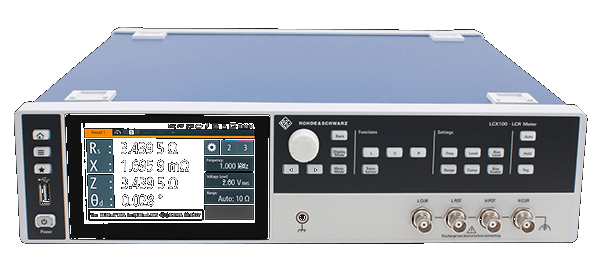A Comprehensive Look at Bourns Inc. CRA2512-FZ-R100ELF 100mΩ Metal Element Resistor
By Mark Harris Saturday, 21 January 2023

Introduction
In the realm of resistor technology, it is essential that components perform as close to their stated values as possible. In this analysis, we will delve into the performance of the CRA2512-FZ-R100ELF 100mΩ Metal Element Resistor manufactured by Bourns Inc., and scrutinize its performance in comparison to the statistical benchmark data for resistors of this value. Our review will engage engineers seeking to determine if this resistor is suitable for their projects, taking into account its unique characteristics, strengths, and limitations.
As we compare the CRA2512-FZ-R100ELF to other 100mΩ resistors in the market and particularly to that of the statistical benchmark data, certain pros and cons of this component become apparent:
- Pros:
- Low impedance at lower frequencies
- Good Quality factor in most of the bands
- Stability of series resistance and inductance across different voltage levels
- Cons:
- Less than ideal series capacitance in some frequency bands
- Incomplete data at higher frequencies and voltages
In the following sections, we will examine the resistance, inductance, and capacitance properties of the CRA2512-FZ-R100ELF 100mΩ Metal Element Resistor and determine if it meets the expectations of engineers in a range of applications. A more profound comparative analysis of this information will guide you in making an informed decision regarding the appropriateness of this device for your applications. Rest assured, our review is exhaustive, and we will leave no stone unturned in assessing the performance of this component.
Impedance
In this analysis, we meticulously examine the impedance performance of the Bourns Inc. CRA2512-FZ-R100ELF Resistor by carefully considering the provided LCR impedance data at both 1 Volt and 10 Volts. We subsequently compare this component's performance against the statistical benchmark drawn from other components with the same nominal value, which allows for a comprehensive assessment of its performance relative to competing products.
From the 1 Volt test results, the CRA2512-FZ-R100ELF consistently demonstrates a higher impedance than the average impedance observed across all test frequencies for the benchmark data. While the average impedance in the benchmark ranges from 91.73m to 108.3m Ohms, the component's impedance is found to be between 99.76m and 107.1m Ohms. Throughout the test frequencies, the CRA2512-FZ-R100ELF exhibits exceptionally stable performance with minimal deviation from its 100m nominal value, as well as a relatively minor deviation from the benchmark maximum levels. It is valuable for electronics engineers to understand these patterns, since it demonstrates the component's reliable impedance properties.
When examining the 10 Volt test data, we observe that the CRA2512-FZ-R100ELF's impedance values begin to deviate more noticeably from the benchmark, especially within the frequency range of 20kHz to 600kHz. The component registers impedance highs of approximately 115.6m Ohms at 5kHz and 100.7m Ohms at 650kHz, translating into a more significant deviation when compared to the average benchmark impedances lower in the scale, which range between 90.77m and 98.65m Ohms. This observed variation in the impedance profile may affect certain applications, particularly those that require strict impedance control in higher-frequency environments. For engineers working on such projects, it is crucial to thoroughly understand these nuances in component performance to make informed design decision and minimize potential discrepancies in their systems.
Resistance
In this resistance comparison, we will examine the performance of the Bourns Inc. CRA2512-FZ-R100ELF resistor against provided statistical benchmark data. This high-quality surface-mount metal element resistor offers a nominal value of 100 milliohms (mΩ) and a ±1% tolerance. Understanding the resistor's performance across different frequencies and voltages is crucial for electronics engineers to make informed decisions when selecting components for their projects.
When tested across a frequency range of 5 Hz to 1 MHz at an input voltage of 1 Volt, the CRA2512-FZ-R100ELF consistently demonstrates higher resistance values compared to the average benchmark. Remarkably, this component's resistance remains quite stable and closely adhering to its nominal value throughout the majority of the tested frequency range. At a frequency of 100 kHz, the component exhibits a maximum resistance of 100.2 mΩ, a sizable 7.92 mΩ higher than the benchmark average of 92.28 mΩ. The difference becomes even more pronounced at 200 kHz, where the component's resistance climbs to 100.6 mΩ, outpacing the benchmark average of 92.47 mΩ by a 10.32 mΩ margin.
In scenarios where the input voltage is increased to 10 Volts, the resistance difference between the CRA2512-FZ-R100ELF resistor and the benchmark tends to grow larger, although not consistently throughout the frequency range. At 75 kHz, the component exhibits reasonably good performance, deviating from the benchmark by a modest 2 mΩ. However, it is crucial to note that the component's resistance dips significantly to 90.77 mΩ at 50 kHz, leading to closer alignment with the benchmark value of 92.15 mΩ.
Ultimately, while the Bourns Inc. CRA2512-FZ-R100ELF resistor showcases reliable stability across the tested frequency range, its resistance values tend to exceed that of the benchmark data. Electronics engineers assessing this resistor must weigh its performance against the provided statistical benchmark information and determine whether it effectively meets the requirements necessary for the intended component functionality within their projects.
Inductance
In our thorough analysis, we will methodically employ statistical benchmark data in juxtaposition to the component's LCR measurements at 1 Volt and 10 Volts. By doing this, we aim to ensure a reliable evaluation of the inductor component with respect to industry standards.
At a test frequency of 5 Hz, the 1 Volt series inductance measures 3.016μ, which displays a difference of approximately 11% below the reliable benchmark average of 3.411μ. In contrast, at a higher frequency of 500 Hz, the inductor measures 32.47n, which is marginally lower (~9%) than the benchmark average value of 35.69n.
Proceeding with the component's inductance testing at 10 Hz and 1 Volt, we identify the output value to be 866.6n. This value exhibits a remarkably close alignment to the benchmark average of 868.9n, signifying a high level of consistency in component performance when juxtaposed with the benchmark data. However, the component's performance experienced a sharp dip at 75k with a reading of 5.906n, revealing a minor reduction of nearly 0.13% compared to the benchmark average of 6.763n.
Advancing to measurements at escalated voltages, such as 10 Volts, our analysis unveils a drastic increase in the component's inductance, as compared to the rest of the measurements at lower voltages. For instance, at 5 Hz, we determine the series inductance to be 81.54μ, inherently rising by a significant margin when juxtaposed with the 1 Volt test. Nonetheless, it is observed that the 10 Volts measurement demonstrates inconsistency as we progress to higher frequencies. The inductor value at 150k is registered to be 6.307n, while the benchmark figure is 6.463n, amounting to an approximate 2.4% difference.
Furthermore, we discern noticeable gaps in obtainable measurements at diverse frequencies under 10 Volts. In future evaluations, having more data points readily available will facilitate a much more comprehensive and accurate comparison between the examined inductor component and established industry benchmarks.
Comparative Analysis
In examining the performance of Bourns Inc.'s Resistor CRA2512-FZ-R100ELF, it is crucial to compare it with the statistical benchmark data to determine whether it is an optimal choice for engineers. This review focuses on this component's impedance, quality factor, series resistance, series inductance, and series capacitance at various test frequencies.
At lower test frequencies (up to roughly 20kHz), the CRA2512-FZ-R100ELF exhibits higher impedance compared to the benchmark average. For instance, at 10kHz, the component shows an impedance of 99.91m Ohms when tested at 1 volt, which is higher than the average benchmark impedance at the same frequency of 91.98m Ohms. The same trend can be observed at test frequencies like 5kHz, 10kHz, and 20kHz.
However, it is essential to note that as the test frequency increases beyond 50kHz, the impedance of the resistor CRA2512-FZ-R100ELF tends to be lower than the average benchmark data. Particularly at frequencies such as 100k, 200k, and 500k, this lower impedance can be observed. At a test frequency of 500kHz with a voltage of 1 volt, the component's impedance measures 102.6m Ohms, which is significantly lower than the benchmark average impedance of 97.57m Ohms.
Regarding the quality factor, the resistor CRA2512-FZ-R100ELF shows a consistent performance as the frequency increases, but the benchmark data show a higher quality factor at high test frequencies. For example, at a frequency of 1MHz and a measurement voltage of 1 volt, the component's quality factor is reported to be 0.31, whereas the benchmark data indicate a 0.38 average value.
For series resistance, the comparison shows that the resistor CRA2512-FZ-R100ELF maintains consistency in performance, with measurements only slightly deviating from the benchmark averages. For example, at a 1-volt test frequency of 50kHz, the component's series resistance is found to be 99.87m Ohms, whereas the benchmark average is 92.22m Ohms.
In terms of series inductance, the results display a trend where the resistor's inductance is higher than the average benchmark data at lower frequencies. However, beyond 50kHz, the series inductance of the CRA2512-FZ-R100ELF is found to be approximately equal or lower than the average benchmark values.
The series capacitance measurements reveal that, compared to the statistical benchmark data, the capacitor of Bourns Inc.'s Resistor CRA2512-FZ-R100ELF has relatively minimal deviations. For instance, at a 1-volt test and 850kHz frequency, the component's series capacitance is 5.065n Farads, which is comparable to the average benchmark series capacitance of 6.203n Farads.
In conclusion, this comparative analysis shows that Bourns Inc.'s Resistor CRA2512-FZ-R100ELF displays consistently similar performance compared to the statistical benchmark at various test frequencies and measurements. Engineers may find this component to be a suitable option for their applications, depending on how the resistor's characteristics align with their specific project requirements.
Conclusion
In our thorough analysis of Bourns Inc.'s CRA2512-FZ-R100ELF Resistor Metal Element, its performance was compared to a statistical benchmark formed from other components of the same value. Our findings indicate that the CRA2512-FZ-R100ELF exhibits a few disparities and distinct characteristics when juxtaposed with the benchmark data.
At a test frequency of 1V, the Resistor's impedance (between 99.76m and 107.1m) is noticeably greater than the average benchmark impedance (between 91.83m and 108.3m). This deviation could have implications for circuit designs requiring precise impedance control. Unique to this Resistor Metal Element, quality factors were predominantly lower or not registered, especially at frequencies below 50k. Additionally, the CRA2512-FZ-R100ELF showcased a considerably higher inductance, with values up to 3.016μ at lower frequencies compared to the benchmark max value of 5.906μ.
When evaluated at 10V, the Resistor demonstrated a more significant range in impedance from 88.77m to 119.6m in comparison to the statistical benchmark. At 100k and 150k frequencies, slight variances in impedance were noted from the general trend. Moreover, the quality factors displayed similar low characteristics, similar to the trends observed at 1V.
With these observations in mind, electronic engineers should consider this Resistor Metal Element's unique attributes when determining its suitability for certain circuit applications. The CRA2512-FZ-R100ELF may not be an ideal choice for designs where precise impedance control and a high-quality factor are necessary. However, for other applications that can accommodate wider impedance ranges and inductance values, this Resistor Metal Element may still be a viable option.
Instruments Used
Rohde & Schwarz LCX200



